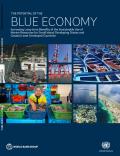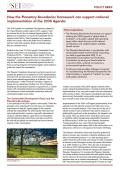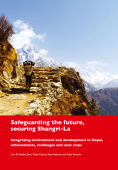
This report was drafted by a working group of United Nations entities, the World Bank, and other stakeholders to suggest a common understanding of the blue economy; to highlight the importance of such an approach, particularly for small island developing states and coastal least developed countries; to identify some of the key challenges its adoption poses; and to suggest some broad next steps that are called for in order to ensure its implementation. Although the term “blue economy” has been used in different ways, it is understood here as comprising the range of economic sectors and related policies that together determine whether the use of oceanic resources is sustainable. An important challenge of the blue economy is thus to understand and better manage the many aspects of oceanic sustainability, ranging from sustainable fisheries to ecosystem health to pollution. A second significant issue is the realization that the sustainable management of ocean resources requires collaboration across nation-states and across the public-private sectors, and on a scale that has not been previously achieved.

Low energy supply, complete with shortages, high costs and poor access, remains major impediments to Africa’s social and economic progress. The African Union’s Agenda 2063 commits to fast-tracking modern, efficient, reliable and cost effective renewable energy for all households, businesses, industries and institutions. To support this, in 2016, the African Development Bank approved its New Deal on Energy for Africa, which aspires to achieving universal access to energy by 2025, using the latest off-grid and technology solutions. This atlas illustrates the incredible transformation ahead.
Universal access requires large financial investments. By some estimates, Africa needs $43-55 billion per year until 2030-2040, compared to current energy investments of about $8-9.2 billion. To achieve closing that gap, an improved understanding of energy availability, distribution and limitations is one of many crucial needs. In response, the African Development Bank, Sustainable Energy Fund for Africa and the Infrastructure Consortium for Africa, worked with UN Environment and produced this Atlas of Africa Energy Resources.

The 2030 Agenda for Sustainable Development, adopted by the United Nations member states in 2015, requires “each government (to set) its own national targets guided by the global level of ambition” set out by the Sustainable Development Goals (SDGs). This formulation leaves question marks over exactly what is the global level of ambition, and how individual countries should set national targets that are consistent with it. One way that the Planetary Boundaries framework can facilitate this process is by defining safe limits for human disturbance of a number of earth system processes – which are easily translated into global levels of ambition. These global ambitions and allocations can then be downscaled to the national level. Furthermore, the downscaled Planetary Boundaries, in combination with consumption-based environmental accounting, can help to operationalize SDG 12 on Sustainable Consumption and Production, in particular, by serving as benchmarks for a country’s total – internal and external – environmental performance.

Nepal has abundant natural assets which underpin the economy and a very diverse ethnic and cultural heritage. These provide a strong platform for sustainable development. But the country suffers from the pervasive degradation of its environment and there is widespread poverty. As Nepal emerges from a period of conflict, the opportunity has emerged to safeguard and manage the environment wisely and build the future on a sustainable basis, and in this way secure a transition to a green economy.
This report, produced by leading Nepali thinkers, explores efforts over the past twenty years to mainstreaming the environment in planning and decision-making, and presents case studies which can act as springboards for further action. It also examines the drivers and challenges to such mainstreaming and makes recommendations for further action. The evidence presented makes a compelling case for change and investing in the environment.

This guide aims to encourage early dialogue and diagnosis in and by developing countries on what a green economy would mean for their country.
Green economy and green growth are hot topics. Definitions, evidence, debates and increasingly, policies, have tended to be dominated by powerful countries and international groups. Several intergovernmental organisations are making it a priority and are announcing policies and programmes; but they each have different approaches.
This proliferating work on the international scene provides rich material which can be highly influential in developing countries. However, there are risks of considerable bias if the concepts are not first explored by stakeholders in-country. As the 2012 Rio+20 United Nations Conference on Sustainable Development concluded, green economies should take very different forms according to a country’s diverse capital endowments and needs. As such, green economic policy and investments need to be tailored at both national and local levels.
